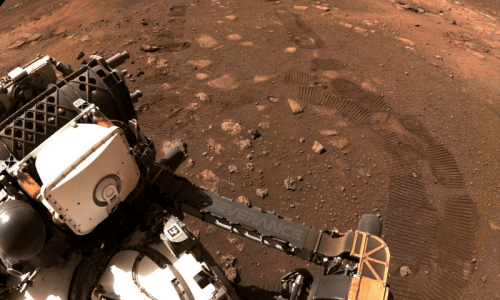Introduction
In an exciting development, China’s Zhurong rover has uncovered new evidence supporting the longstanding theory that Mars was once home to a vast ocean. This discovery, which includes tracing ancient coastlines, has added a significant chapter to our understanding of the Red Planet’s history. The findings, published in the journal Nature, have sparked renewed interest and debate among scientists about Mars’ potential to have once supported life.
The Zhurong Rover and Its Mission
Landing and Exploration
In 2021, China’s Zhurong rover successfully landed on the Utopia Planitia in the Martian northern hemisphere. This region had previously shown indications of ancient water activity, making it a prime location for further investigation. Since its landing, the rover has been diligently probing the Martian surface, gathering valuable data to understand the planet’s past.
Technological Marvel
The Zhurong rover is equipped with state-of-the-art instruments designed to analyze the Martian terrain and atmosphere. These tools have enabled scientists to uncover features that suggest the presence of a past ocean, adding substantial weight to the theory that Mars once harbored significant bodies of water.
Evidence of an Ancient Ocean
Geological Features
Lead study author Bo Wu from The Hong Kong Polytechnic University and his team have identified several geological features around Zhurong’s landing area that hint at a watery past. These features include “pitted cones, polygonal troughs, and etched flows,” which are indicative of water or ice-related processes.
Pitted Cones
The crater-like pitted cones observed could be remnants of mud volcanoes, typically forming in regions where water or ice was once present. This suggests that the area experienced significant geological activity influenced by water.
Polygonal Troughs
Polygonal troughs are another compelling piece of evidence. These formations often occur in areas that have undergone freeze-thaw cycles, supporting the idea that Mars experienced periods of liquid water followed by freezing.
Etched Flows
Etched flows indicate the movement of sediment and possibly water across the surface, carving out distinct patterns that are now visible through satellite imagery and the rover’s instruments.
Shoreline Indicators
Satellite data, combined with the rover’s findings, suggest that a shoreline once existed near Zhurong’s landing site. The study estimates that this ocean was formed by a massive flooding event approximately 3.7 billion years ago. Over time, the ocean is believed to have frozen, creating a coastline before eventually disappearing around 3.4 billion years ago.
The Debate Among Scientists
Scepticism and Support
While the findings are compelling, they have not gone without skepticism. Benjamin Cardenas, a scientist who has analyzed other evidence of a Martian ocean, expressed reservations about the new study. He argued that the researchers may not have fully considered the effects of Martian wind on sediment and rock erosion over billions of years.
Martian Wind and Erosion
Cardenas pointed out that even slow erosion rates on Mars could significantly alter the landscape over such long periods, potentially erasing signs of ancient shorelines. This perspective underscores the need for cautious interpretation of the data.
Impact of Meteors
Bo Wu acknowledged that wind erosion might have played a role but emphasized that meteors striking Mars could have periodically exposed underground rock and sediment, providing snapshots of the planet’s geological history.
The Ongoing Debate
Despite the contentious nature of the theory, many scientists, including Cardenas, lean towards the existence of an ancient ocean on Mars. This theory, if proven, could have profound implications for our understanding of the potential for life on Mars and the early conditions of the planet.
Implications for the Search for Life
The Role of Water in Life
Water is a critical ingredient for life as we know it. On Earth, life is believed to have originated in environments rich in water, such as undersea hydrothermal vents or tidal pools where water and air interact. The presence of an ancient ocean on Mars would make the planet appear more hospitable and a promising candidate in the search for extraterrestrial life.
Future Missions and Research
To definitively prove the existence of an ancient ocean on Mars, future missions will need to bring back samples of Martian rocks and sediment to Earth for detailed analysis. These missions will help unravel the mystery of whether Mars once supported life and how its environment has changed over billions of years.
FAQs
1. What evidence did the Zhurong rover find to suggest an ancient ocean on Mars?
The Zhurong rover identified several geological features, including pitted cones, polygonal troughs, and etched flows, that suggest the presence of past water or ice-related activity. Satellite data also indicated the existence of a former shoreline near the rover’s landing site.
2. Why is there skepticism about the new findings?
Some scientists, like Benjamin Cardenas, believe that the researchers may not have fully accounted for the effects of Martian wind on sediment and rock erosion over billions of years. This skepticism highlights the need for further investigation and cautious interpretation of the data.
3. How did the potential ocean on Mars form and disappear?
The study suggests that the ocean was created by a massive flooding event around 3.7 billion years ago. Over time, the ocean froze, creating a visible coastline, and eventually disappeared around 3.4 billion years ago due to climatic changes.
4. What are the implications of finding an ancient ocean on Mars?
Discovering an ancient ocean on Mars would imply that the planet once had conditions suitable for life. This finding would make Mars a prime candidate in the search for extraterrestrial life and provide insights into the early conditions of the planet.
5. What future missions are planned to investigate Mars’ ancient ocean?
Future missions aim to bring back samples of Martian rocks and sediment to Earth for detailed analysis. These missions will help scientists definitively determine whether Mars once had an ocean and potentially supported life.
Conclusion
The discovery of potential signs of an ancient ocean on Mars by China’s Zhurong rover has reignited the scientific debate about the Red Planet’s past. While the findings are promising, further research and missions are necessary to confirm the existence of this ocean and its implications for the search for life beyond Earth. The continued exploration of Mars will undoubtedly yield more fascinating discoveries, bringing us closer to understanding our neighboring planet’s history and its potential for life.
ALSO READ:



